What You Need To Know To Build Your AR-15 Lower Receiver
Welcome to our blog post on “Identifying AR-15 Lower Receiver Parts”. The AR-15 is a versatile and popular firearm platform, and understanding the different components of the lower receiver is important for any AR-15 owner. This blog post will provide a comprehensive guide to help you identify and understand the various parts of the lower receiver. We will cover each component’s function and significance, from the fire control group and magazine catch to the buffer tube and takedown pins. Whether you are new to the AR-15 platform or looking to deepen your knowledge, this Identifying AR-15 Lower Receiver Parts” guide will equip you with the necessary information to identify and appreciate the intricacies of AR-15 lower receiver parts”. So, let’s dive in and explore the world of AR-15 lower receiver components together!
Table of contents
Main Lower Receiver Parts
The AR-15 lower receiver houses several crucial components that allow for the function and operation of the firearm. The lower receiver is the foundation, providing the attachment points for other parts. Each component plays a vital role in the proper functioning and control of the AR-15 rifle, contributing to its reliability, safety, and overall shooting experience.
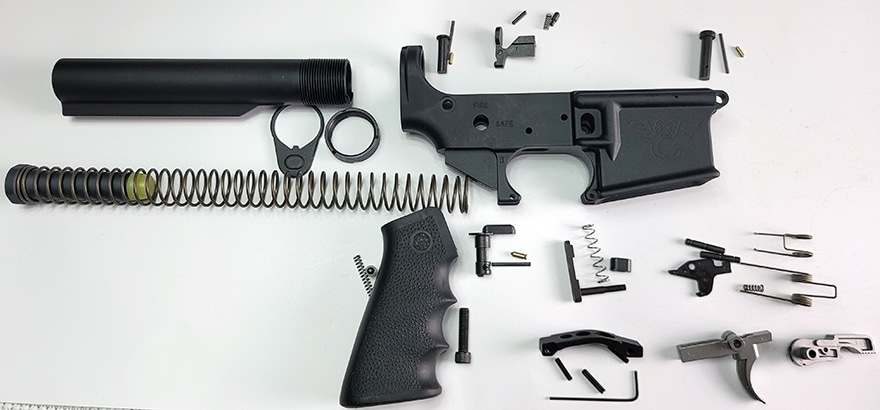
An AR-15 lower receiver typically contains numerous small parts, including springs and pins. While the exact number can vary slightly depending on the specific lower receiver and any added customization, a standard AR-15 lower receiver can have around 30 to 40 individual parts. This includes components such as the trigger, hammer, disconnector, safety selector, pivot pin, takedown pin, magazine release button, bolt catch, buffer retainer pin, trigger guard roll pin, and various springs like the trigger spring, hammer spring, and buffer spring, among others. Each of these parts plays an important role in the proper functioning and operation of the AR-15 lower receiver.
AR-15 Lower Parts List:
- Trigger
- Trigger spring
- Trigger Pins (2)
- Disconnector
- Disconnector Spring
- Hammer
- Hammer spring
- Trigger Guard
- Trigger guard roll pin
- Bolt Catch
- Bolt catch buffer
- Bolt catch spring
- Bolt Catch roll pin
- Magazine Catch
- Magazine catch button
- Magazine catch spring
- Selector
- Selector Spring
- Selector detent
- Pistol Grip
- Pistol grip screw
- Buffer
- Buffer Tube
- Buffer end plate
- Castle nut
- Buffer retainer
- Buffer retainer spring
- Pivot Pin
- Pivot pin spring
- Pivot pin detent
- Takedown pin
- Takedown pin spring
- Takedown pin detent
Pistol grip:

The pistol grip on an AR-15’s lower receiver is a handle located at the rear of the firearm. The pistol grip allows for better control and stability while handling the firearm.
The primary function of the pistol grip is to allow the shooter to securely hold the AR-15 and maintain a firm grip while firing. It typically has textured or checkered surfaces to enhance the shooter’s grip.
Additionally, the pistol grip houses the grip screw, which attaches and secures the grip to the lower receiver.
The pistol grip can also serve as a housing for certain optional accessories or add-ons. Some grips feature a storage compartment holding small items such as spare batteries or cleaning supplies. Additionally, aftermarket grip options offer modular designs, allowing the attachment of accessories such as pressure switches for lights or lasers.
Trigger
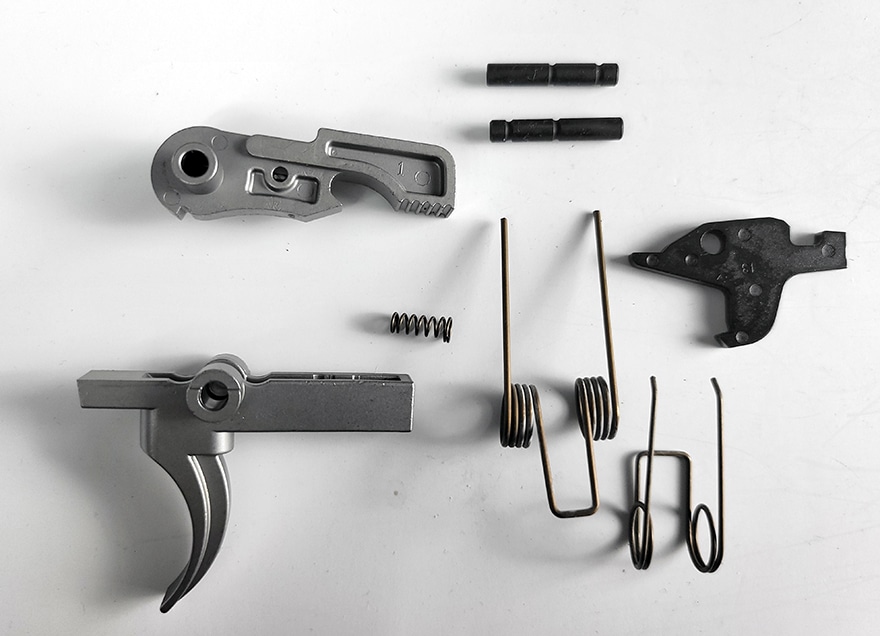
The fire control group (FCG) is housed within the lower receiver of an AR-15 rifle. It consists of several parts working together to facilitate the firing sequence and control the firearm’s operation.
The main components of the AR-15 fire control group include the trigger, hammer, disconnector, and associated springs. Here’s how they function:
- Trigger: The trigger is the part the shooter pulls to initiate the firing process. When the trigger is pulled, it engages the hammer.
- Hammer: The hammer is held in a cocked position until the trigger is pulled. When the trigger engages the hammer, it is released to strike the firing pin, igniting the primer of the chambered round.
- Disconnector: The disconnector is a safety feature that ensures the hammer only strikes the firing pin when the trigger is pulled and held to the rear. During the firing cycle, it momentarily interrupts the connection between the trigger and hammer to allow the bolt carrier group to reset.
- Springs: The fire control group also includes various springs, such as the trigger spring, hammer spring, and disconnector spring. These springs provide tension and help facilitate the smooth operation and reset of the trigger, hammer, and disconnector.
The interaction between these components determines the firearm’s firing mode. In a standard AR-15, the fire control group operates semi-automatic, meaning the firearm fires one round per trigger pull. After firing, the bolt carrier group cycles, extracting and ejecting the spent casing and chambering a fresh round from the magazine.
It’s important to note that certain modifications or variations of the fire control group can allow for different firing modes, such as binary, burst, or fully automatic. However, these modifications are subject to legal restrictions and regulations in many jurisdictions.
Trigger Guard
The trigger guard is the curved or straight component surrounding the trigger assembly. It protects the trigger mechanism and helps prevent accidental trigger manipulation.
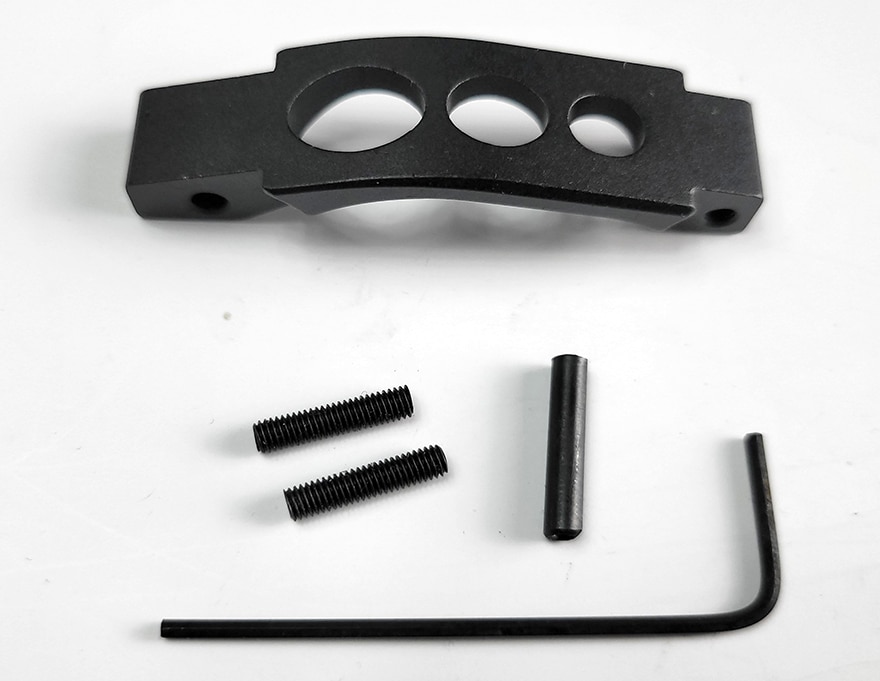
Bolt Catch
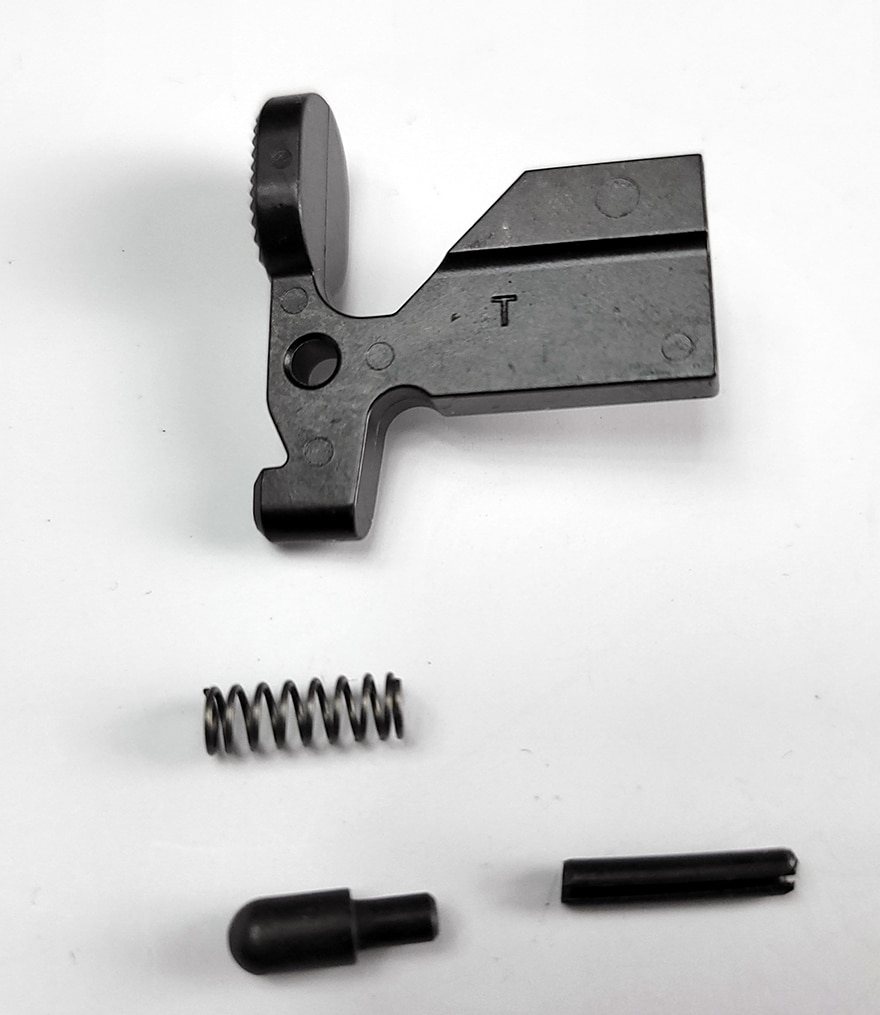
The bolt catch is a mechanism on the side of an AR-15’s lower receiver that serves several important functions. The primary function of the bolt catch is to hold the bolt carrier group (BCG) open after the last round in the magazine has been fired. When the magazine is empty, the upward movement of the follower pushes the bolt catch upward, engaging the bolt catch notch on the BCG. This locks the BCG in the rearward position, indicating that the firearm is empty and needs to be reloaded.
The bolt catch can also be manually activated to lock the BCG open for inspection, maintenance, or
troubleshooting. Pulling the charging handle rearward and pushing up on the bolt catch allows the BCG to be locked in the open position, allowing easier access to the chamber and other internal components.
To release the bolt catch and allow the BCG to move forward, the shooter can either insert a loaded magazine and depress the bolt catch or pull back and release the charging handle. This releases the catch, allowing the BCG to move forward, chambering a round from the magazine.
The bolt catch also plays a role in facilitating the reloading process. When the shooter inserts a new magazine into the magazine well, the upward movement of the magazine follower pushes against the bolt catch, causing it to disengage from the BCG. This allows the BCG to advance and chamber a round from the newly inserted magazine.
Magazine Catch
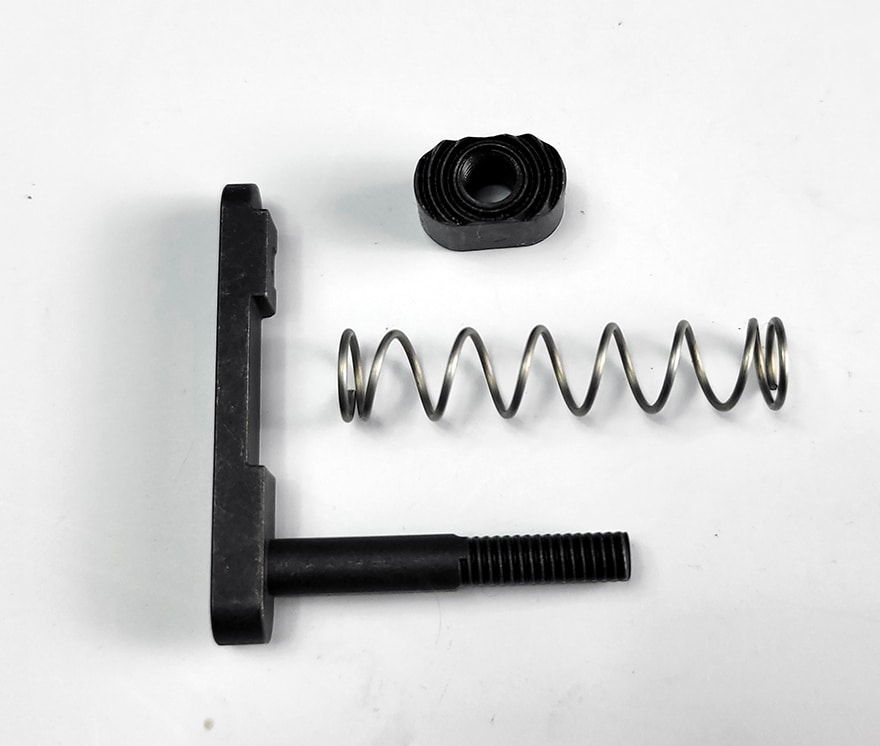
The magazine catch, also known as the mag catch or magazine release, is an essential component on the side of an AR-15’s lower receiver. It serves the crucial function of securely holding and releasing the magazine from the firearm.
The magazine catch consists of a button or lever that, when pressed or manipulated, allows the magazine to be inserted or removed from the magazine well. Here’s how it works:
- Magazine Insertion: The shooter positions the magazine against the magazine well on the lower receiver to insert a magazine. By pressing or activating the magazine catch, the catch’s internal mechanism disengages, allowing it to be inserted fully into the magazine well until it locks into place.
- Magazine Release: When removing the magazine, the shooter depresses or manipulates the catch button or lever. This action releases the catch’s engagement with the magazine, allowing the magazine to be pulled out of the magazine well.
The magazine catch is designed to securely hold the magazine in place during shooting while allowing for efficient and quick changes. It ensures the magazine is firmly seated, preventing unintended dislodging or movement during firearm operation.
The magazine catch is typically designed to be ambidextrous, meaning it can be operated by both right-handed and left-handed shooters. This allows for ease of use and accessibility, regardless of the shooter’s dominant hand.
It’s worth noting that aftermarket magazine catch options are available, offering extended or enhanced designs to provide increased leverage, ease of use, or additional customization options.
Buffer System
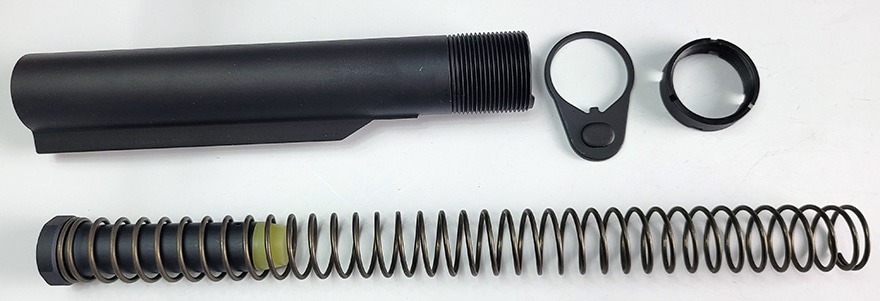
The buffer tube serves multiple important functions contributing to the firearm’s operation and overall shooting experience.
- Recoil Management: The buffer tube houses the recoil buffer and buffer spring. When the AR-15 is fired, the gas pressure from the discharged round forces the bolt carrier group (BCG) to rearward. The buffer spring and buffer within the buffer tube absorb and mitigate the recoil energy generated during this process. They work in tandem to control the rearward movement of the BCG and help ensure the firearm cycles reliably and smoothly.
- Bolt Carrier Group Cycling: The buffer tube’s recoil system assists in the cyclic operation of the AR-15. After a round is fired, the buffer and buffer spring return the BCG to its forward position, chambering a fresh round from the magazine.
- Stock or Brace Attachment: The buffer tube provides the attachment point for the stock or brace of the AR-15.
Additional Buffer Tube Options
It’s important to note that the buffer tube can come in different lengths and configurations to accommodate various stock or brace types and shooting preferences. Common variations include mil-spec and commercial-spec buffer tubes, which differ in their external diameter and corresponding stock compatibility.
The design of the buffer tube also affects the length of the pull, which refers to the distance from the trigger to the buttstock or brace when fully extended. This allows shooters to adjust the firearm’s fit to their preferences, optimizing comfort and shooting ergonomics.
Buffer
The buffer in an AR-15’s lower receiver is a crucial component that works with the buffer spring and tube to manage the recoil generated when firing the firearm. It serves several important functions:
- Recoil Absorption: The buffer primarily absorbs and dissipates the recoil energy generated when a round is fired. As the bolt carrier group (BCG) moves rearward during the firing process, the buffer compresses against the buffer spring, absorbing the recoil forces. This action helps reduce the felt recoil and muzzle rise, allowing for more controlled and comfortable shooting.
- Bolt Carrier Group Cycling: The buffer plays a vital role in the cyclic operation of the AR-15. After a round is fired, the buffer and buffer spring work together to return the BCG to its forward position. The stored energy in the compressed buffer spring pushes the buffer forward, which, in turn, drives the BCG back into the battery, chambering the next round from the magazine. This cycling process continues as long as the firearm is being fired.
- Dampening Bolt Carrier Group Movement: The buffer also helps control the movement of the BCG during firing. The buffer slows down its travel by providing resistance against the BCG’s rearward motion, ensuring controlled and reliable cycling. This helps regulate the rate of fire and prevents excessive wear and stress on the firearm’s internal components.
Buffer Configurations

Buffers in AR-15 rifles can come in different weights and designs to accommodate various shooting preferences and ammunition types. Heavier buffers are typically used for mitigating recoil in larger caliber AR-15s or for specific shooting applications.
The main classifications of AR-15 buffers include:
- Standard Carbine Buffer (Carbine): This is the lightest buffer and is generally the standard weight for M4 carbine clones.
- H Buffer: Weigh more than the standard carbine buffer. The “H” stands for heavy. It often contains one or two tungsten weights combined with steel weights.
- H2 Buffer: This is heavier than the H buffer.
- H3 Buffer: Even heavier.
- Rifle Buffer: This is designed for the original AR-15 and M16 design with a fixed stock and longer buffer tube.
- Pistol Buffer: Specifically designed for AR-15 pistols, these might not always differ much from a standard carbine buffer.
- Specialized Buffers: There are other specialized buffers for specific uses or calibers, such as the 9mm buffer for AR platforms chambered in 9mm.
Spring
The buffer spring in an AR-15’s lower receiver works in conjunction with the buffer to manage recoil and facilitate the cyclic operation of the firearm. It plays several important roles in the functioning of the AR-15 platform.

The function of Buffer Spring
- Recoil Management: The buffer spring absorbs and manages the recoil energy generated when firing the firearm. The buffer spring is compressed as the bolt carrier group (BCG) moves rearward during the firing process. This compression absorbs and mitigates the recoil forces, helping to reduce felt recoil and muzzle rise. The buffer spring’s ability to absorb and control the energy is crucial in maintaining control and allowing for more accurate follow-up shots.
- Bolt Carrier Group Cycling: The buffer spring provides the energy required to cycle the bolt carrier group. After a round is fired, the stored energy in the compressed buffer spring pushes the buffer forward, which, in turn, drives the BCG back into the battery. The cyclic motion of the BCG chambers a fresh round from the magazine, resets the hammer and readies the firearm for the next shot. The buffer spring’s resilience and ability to exert force in a controlled manner are key to reliable cycling and overall firearm function.
- Rate of Fire Regulation: The tension and characteristics of the buffer spring can impact the rate of fire of the AR-15. Different buffer springs can affect the timing and speed at which the BCG cycles, influencing the cyclic rate. Shooters can choose other buffer springs to fine-tune the firearm’s performance and optimize it for specific shooting applications or ammunition types.
It’s worth noting that buffer springs can come in various lengths, materials, and designs.
Receiver extension (also known as a buffer tube extension)
The receiver extension, also commonly referred to as the buffer tube, is a component located at the rear of an AR-15’s lower receiver. It serves several important functions that contribute to the firearm’s overall function and ergonomics:

- Attachment Point for Stock or Brace: The receiver extension provides the attachment point for the stock or brace of the AR-15. It features external threads or a castle nut, allowing the stock or brace to be securely mounted to the lower receiver.
- Housing for Buffer and Buffer Spring: The receiver extension houses the recoil buffer and buffer spring. These components work together to manage recoil energy and facilitate the cyclic operation of the firearm.
- Adjustment of Length of Pull (LOP): The receiver extension can be found in different lengths, offering options for adjusting the length of pull. The length of pull refers to the distance between the trigger and the stock or brace when fully extended. Shooters with different arm lengths or preferences can choose a receiver extension that suits their needs, allowing for a more comfortable and personalized shooting experience.
- Buffer Tube Diameter and Compatibility: The receiver extension comes in different diameters, commonly known as mil-spec (military specification) and commercial-spec. The mil-spec buffer tube is slightly smaller than the commercial-spec buffer tube. The choice of buffer tube diameter affects the compatibility of stocks or braces and other accessories designed to fit specific buffer tube specifications.
It’s important to note that using a specific receiver extension, whether mil-spec or commercial-spec, typically determines the corresponding stock or brace compatibility.
Takedown Pin

The takedown pin on an AR-15’s lower receiver facilitates the disassembly and assembly of the firearm. It serves the following functions:
- Upper and Lower Receiver Separation: The takedown pin, together with its corresponding counterpart, the pivot pin, holds the upper and lower receivers of the AR-15 together. By removing the takedown pin, the upper and lower receivers can be separated, allowing access to the internal components for cleaning, maintenance, and customization.
- Field Stripping and Maintenance: Removing the takedown pin is essential in stripping the AR-15 for cleaning and maintenance. When the takedown pin is pulled out, it allows the upper receiver to pivot open on the pivot pin, exposing the bolt carrier group, charging handle, and other internal components. This enables the shooter to clean, inspect, and perform necessary maintenance on the firearm.
- Lower Receiver Assembly: When reassembling the AR-15, the takedown pin is inserted back into the lower receiver, aligning it with the corresponding hole in the upper receiver. The takedown pin secures the upper and lower receivers together, ensuring proper alignment and stability during shooting.
- Receiver Customization: The takedown pin also plays a role in receiver customization. Some shooters opt for extended or enhanced takedown pins, which provide easier manipulation and faster disassembly or assembly of the firearm. These aftermarket options can offer improved ergonomics and convenience.
Takedown Pin Function
It’s important to note that the takedown pin is usually spring-loaded, allowing it to stay securely in place during normal operation. It’s removed by pulling it out from the side of the lower receiver.
The takedown pin on an AR-15’s lower receiver separates the upper and lower receivers, facilitating field stripping, maintenance, and firearm customization.
Pivot Pin
The pivot pin on an AR-15’s lower receiver is a crucial component that works with the takedown pin to hold the upper and lower receivers of the firearm together. It serves several important functions:
- Upper and Lower Receiver Connection: The pivot pin, along with its corresponding counterpart, the takedown pin, secures the upper and lower receivers together. When inserted, the pivot pin aligns with the corresponding holes in the upper and lower receivers, creating a pivot point. This connection ensures the proper alignment and stability of the firearm during use.
- Field Stripping and Maintenance: The pivot pin plays a significant role in field stripping the AR-15 for cleaning and maintenance. The pivot pin is pulled out to field strip the firearm. This allows the upper receiver to pivot open on the takedown pin. This exposes the internal components, such as the bolt carrier group and charging handle, for cleaning, inspection, and maintenance.
- Lower Receiver Assembly: When reassembling the AR-15, the pivot pin is inserted back into the lower receiver. Aligning it with the corresponding holes in the upper receiver. The pivot pin secures the upper and lower receivers together, ensuring proper alignment and stability during shooting.
- Receiver Customization: The pivot pin can also be a consideration for customization. Some shooters opt for extended or enhanced pivot pins, which offer easier manipulation and faster disassembly or assembly. These aftermarket options can provide improved ergonomics and convenience.
Like the takedown pin, the pivot pin is typically spring-loaded, allowing it to stay securely in place during normal operation.
Assembling an AR15 Lower Receiver
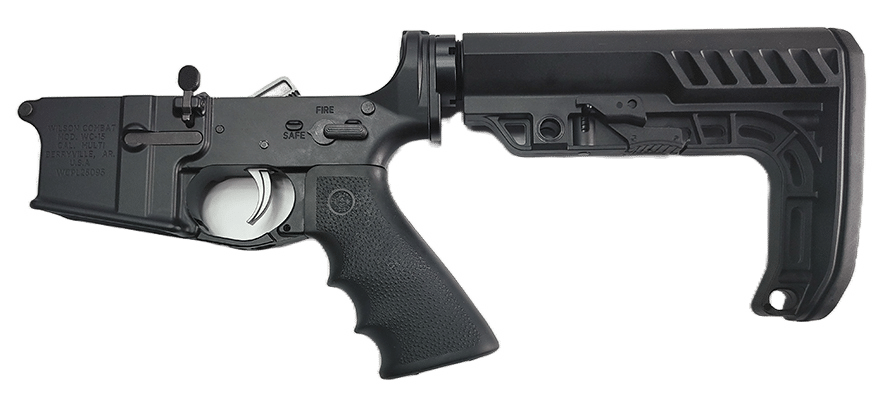
Assembling an AR-15 lower receiver is a straightforward process, but it requires careful attention to detail and proper technique to ensure a safe and functional firearm. Always follow the manufacturer’s instructions and consult a professional gunsmith with any questions or concerns. We have a step-by-step blog post on lower receiver assembly coming out next week.
Identifying AR-15 Lower Receiver Parts Conclusion
In conclusion, understanding the various parts that comprise the AR-15 lower receiver is a good idea for any AR-15 enthusiast or owner. Each component plays a specific role in the firearm’s function and operation. By familiarizing yourself with these parts, such as the fire control group, magazine catch, buffer tube, takedown pins, and more, you can better understand how your AR-15 functions and even explore customization options.
This guide has provided you with the necessary information to identify and appreciate the intricacies of AR-15 lower receiver parts. Always adhere to legal requirements and consult professionals when performing any modifications or maintenance on your AR-15. We hope this guide has been helpful, and we invite you to continue exploring the fascinating world of AR-15 firearms. Happy shooting!
Identifying AR-15 Lower Receiver Parts FAQs
The fire control group consists of the trigger, hammer, and disconnector. The trigger is the part you pull to initiate firing, while the hammer strikes the firing pin. The disconnector controls the timing of the firing sequence.
The safety selector allows the shooter to choose between safe, semi-automatic, and, in some cases, automatic firing modes. It is typically located on the side of the lower receiver.
The magazine catch is a button or lever on the lower receiver’s side. It allows for the insertion and removal of the magazine. After firing the last round, the bolt catch holds the bolt carrier group open.
The pivot pin and takedown pin secure the upper and lower receivers together. The pivot pin is located in the reader of the lower receiver and allows the upper receiver to pivot open. The takedown pin is in the front of the lower receiver and enables the upper and lower receivers to separate.
The buffer tube, known as the receiver extension, houses the recoil buffer and buffer spring. It absorbs recoil energy, facilitates the cycling of the BCG, and provides an attachment point for the stock or brace.



